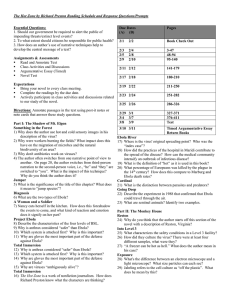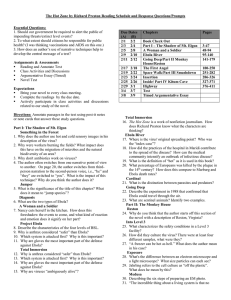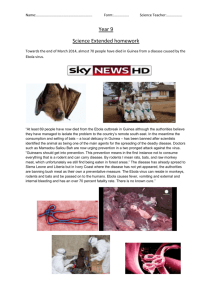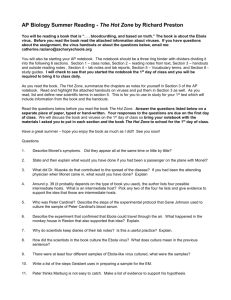The Hot Zone by Richard Preston Reading Schedule and Response
advertisement
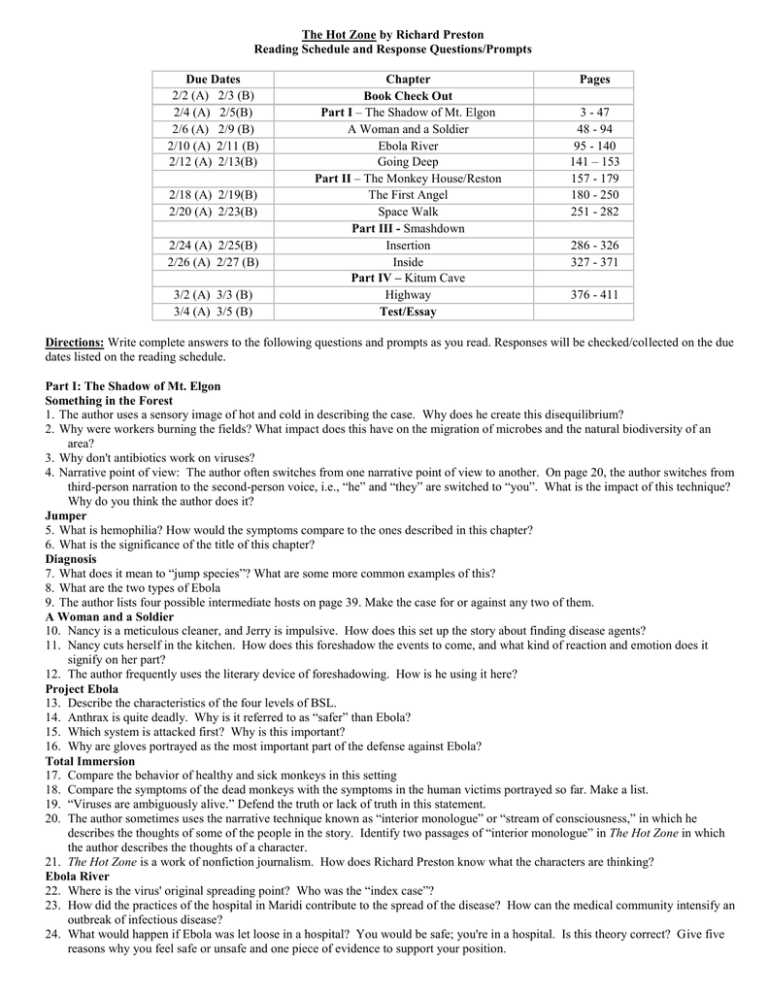
The Hot Zone by Richard Preston Reading Schedule and Response Questions/Prompts Due Dates 2/2 (A) 2/3 (B) 2/4 (A) 2/5(B) 2/6 (A) 2/9 (B) 2/10 (A) 2/11 (B) 2/12 (A) 2/13(B) 2/18 (A) 2/19(B) 2/20 (A) 2/23(B) 2/24 (A) 2/25(B) 2/26 (A) 2/27 (B) 3/2 (A) 3/3 (B) 3/4 (A) 3/5 (B) Chapter Book Check Out Part I – The Shadow of Mt. Elgon A Woman and a Soldier Ebola River Going Deep Part II – The Monkey House/Reston The First Angel Space Walk Part III - Smashdown Insertion Inside Part IV – Kitum Cave Highway Test/Essay Pages 3 - 47 48 - 94 95 - 140 141 – 153 157 - 179 180 - 250 251 - 282 286 - 326 327 - 371 376 - 411 Directions: Write complete answers to the following questions and prompts as you read. Responses will be checked/collected on the due dates listed on the reading schedule. Part I: The Shadow of Mt. Elgon Something in the Forest 1. The author uses a sensory image of hot and cold in describing the case. Why does he create this disequilibrium? 2. Why were workers burning the fields? What impact does this have on the migration of microbes and the natural biodiversity of an area? 3. Why don't antibiotics work on viruses? 4. Narrative point of view: The author often switches from one narrative point of view to another. On page 20, the author switches from third-person narration to the second-person voice, i.e., “he” and “they” are switched to “you”. What is the impact of this technique? Why do you think the author does it? Jumper 5. What is hemophilia? How would the symptoms compare to the ones described in this chapter? 6. What is the significance of the title of this chapter? Diagnosis 7. What does it mean to “jump species”? What are some more common examples of this? 8. What are the two types of Ebola 9. The author lists four possible intermediate hosts on page 39. Make the case for or against any two of them. A Woman and a Soldier 10. Nancy is a meticulous cleaner, and Jerry is impulsive. How does this set up the story about finding disease agents? 11. Nancy cuts herself in the kitchen. How does this foreshadow the events to come, and what kind of reaction and emotion does it signify on her part? 12. The author frequently uses the literary device of foreshadowing. How is he using it here? Project Ebola 13. Describe the characteristics of the four levels of BSL. 14. Anthrax is quite deadly. Why is it referred to as “safer” than Ebola? 15. Which system is attacked first? Why is this important? 16. Why are gloves portrayed as the most important part of the defense against Ebola? Total Immersion 17. Compare the behavior of healthy and sick monkeys in this setting 18. Compare the symptoms of the dead monkeys with the symptoms in the human victims portrayed so far. Make a list. 19. “Viruses are ambiguously alive.” Defend the truth or lack of truth in this statement. 20. The author sometimes uses the narrative technique known as “interior monologue” or “stream of consciousness,” in which he describes the thoughts of some of the people in the story. Identify two passages of “interior monologue” in The Hot Zone in which the author describes the thoughts of a character. 21. The Hot Zone is a work of nonfiction journalism. How does Richard Preston know what the characters are thinking? Ebola River 22. Where is the virus' original spreading point? Who was the “index case”? 23. How did the practices of the hospital in Maridi contribute to the spread of the disease? How can the medical community intensify an outbreak of infectious disease? 24. What would happen if Ebola was let loose in a hospital? You would be safe; you're in a hospital. Is this theory correct? Give five reasons why you feel safe or unsafe and one piece of evidence to support your position. 25. Define “hot” as it is used in this book. 26. What percentage of Europeans was killed by the plague in the 14 th century? What percentage of Americans was killed by the flu in the 1918? Cardinal 27. What is the distinction between parasites and predators? Going Deep 28. Describe the experiment in 1988 that confirmed that Ebola could travel through the air 29. What are sentinel animals? Give two examples. Part II: The Monkey House Reston 30. Why do you think that the author starts off this section of the novel with a description of Reston, Virginia? 31. Is a big suburban area like Reston a good place for a facility like this? List 5 reasons pro and 5 reasons con in terms of business location. Into Level 3 32. What characterizes the safety conditions in a Level 3 facility? 33. How did they culture the virus? There were at least four different samples, what were they? 34. “A freezer can be hot as hell.” What does the author mean in his case? Exposure 35. What's the difference between an electron microscope and a light microscope? What size particles can each see? 36. Jahrling refers to the cell culture as “off the plastic”. What does he mean by this? Thanksgiving 37. List three hypotheses about how the virus had apparently jumped from Room F to Room H. Medusa 38. Describing the six steps of preparing an EM photo. 39. “The incredible thing about a living system is that no matter how small the view, it is just as complicated as ever”. What does the author mean by this? Describe the complexity at the cellular or molecular level. 40. The author likens the image to the face of Medusa. Find a picture or image of Medusa, Describe why the author uses this analogy and how it fits. 41. In retrospect, what was the “pepper” that Tom had seen under the light microscope. The First Angel 42. Compare Gene Johnson's and Peter Jahrling's offices, What does this tell you about their personalities? 43. How do some patients respond to life in the Slammer? Describe how you would react to being in a solitary confinement with a possible fatal exposure to some pathogen? 44. The author frequently employs narrative suspense as a literary device. How does he use it here. The Second Angel 45. What did the evidence from monkey 053's cells show? 46. Explain the procedure and results of the test Jahrling performed to find out what virus was present in the monkeys. The Chain of Command 47. What is a thread virus? 48. Why is it important to know how the viruses spread? 49. What are three ways to eliminate a virus? Which are or are not applicable at this point? 50. Why would there by tension between the Army and CDC? 51. “To be a good officer you must be willing to order the death of the thing you love.” How does this quote relate to Jerry Jaax? Garbage Bags 52. What did Volt tell Dan? How did that affect his next set of decisions? 53. What is “extreme amplification”? 54. “The Army might have to act decisively to put out this fire.” What does this mean? 55. Why did they have to move fast with these specimens? Why couldn't they wait? Space Walk 56. How did life in level 4 compare to a spacewalk? 57. Describe the steps to take prior to going into a Level 4 zone. 58. How does the author characterize the states of order and disorder in life and death terms? Why are viruses an exception to this rule? Shootout 59. Describe the scene inside the hut in the Zande village? 60. How did the Army and CDC resolve the issue of who would be “in charge” of the research containment, and reaction to the virus? Mission 61. What were the three priorities set up by the team? Do you agree with the priorities set up by the team? Why or why not? 62. Why is Kitum Cave so important to the story? How was the monkey house like Kitum Cave? Reconnaissance 63. What was the plan for December 1? What time were they going to start? Why? 64. Why do you think Bill Volt wasn't concerned about being in the monkey house? Do you think his opinion changed when Gene Johnson and Sergeant Klages were afraid to touch things in his office? 65. If you were Dalgard, how would you have responded to the concerns of the lab workers? 66. What would you do if you were involved in the Reston operation and you saw one of the monkeys escape its cage? 67. What is the dramatic effect of the lengthy description of the normal family life of the Jaax family? Part III: Smashdown Insertion 68. After looking at the list of items carried in, list three other items you would have brought. Explain the importance of your choices. 69. Who do you think leaked the news to the Washington Post? Why? 70. What is the tone of this story? Reassuring or frightening? Does it lend an air of confidence or add to the fright factor? 71. Do you think this tory is accurate given what you know? What were some of CJ's thoughts in preparing to give the interview? 72. After the care and thorough description of the Army operation, why does the author end this chapter with the frenzied symptoms of Frantig's illness? A Man Down 73. Compare Frantig's symptoms with Monet, Musoke, and Peter Cardinal. Given Dalgard's fears and what you know by now, what would you have said to Frantig? 74. Describe all the human contacts you have had since you got up this morning. In case of a dangerous exposure, how would you begin the process of contacting them and maybe quarantining them? 75. If it is hot inside and cold outside, what happens if you open a window? What are the dangerous consequences associated with this possibility? 91 Tangos 76. What are some problems you would experience in wearing a space suit? 77. Jahrling is convinced that the virus is airborne and easily spread. McCormick thinks that it is not easily spread. Given Gene Johnson's expertise, how would you evaluate the risk at this point? 78. What were 4 symptoms Jerry saw as he moved around? 79. Why does the coughing and sneezing worry Jerry? What comparison does the author make in this case and why? 80. What was the most dangerous part of the job and why? Inside 81. In debriefing this very long day, a. Make a timeline of events (use chapter subheading if that helps) b. Write four recommendations to CJ about things that worked and things that did not work. A Bad Day 82. What were Frantig's results on the Ebola test? What would have happened if it had come up with the opposite result? 83. Compare the procedures and actions on the second day with those of the first. 84. Why did Jerry veto the idea of shooting the monkey? How did he end up moving through that room? What equipment did he have? 85. “This environment favors the monkey over us.” List evidence to support or refute this statement. 86. Compare the technique of a good injection with a bad one. How could they tell by the effects? Decon 87. When was the last monkey killed? 88. What was the final step in sterilizing the monkey house? 89. “Sometimes it is better to be lucky than smart”. Explain the quote and circumstances in the novel. The Most Dangerous Strain 90. What did the second outbreak of the virus tell researchers about the nature of the Ebola virus? 91. “Imagine a virus with the infectiousness of the flu and the mortality rate of the black plague”. What could we do to protect ourselves against this? Part IV: Kitum Cave Highway 92. The author has changed the narrative point of view. What is the narrative point of view now? What's the author trying to accomplish by this change? Give some reasons why the author might have changed the point of view. 93. Describe the disaster plan the author and Robin joke about. Who are the Flying Doctors? Camp 94. Describe Kitale. 95. List the species noticed coming in and out of the cave. What other species do you think might be present that the author missed seeing? (Consider nocturnal species.) 96. What makes Kitum Cave “a nice place for a virus to jump species”? 97. What does the author speculate is the cause of the rise in rain forest viruses in humans? 98. The author uses a poetic metaphor, “the revenge of the rain forest,” to describe a scientific hypothesis. What is the hypothesis? How accurately/inaccurately does the metaphor portray it? What do you think about the use of imagery and metaphor to describe scientific materials? Is this good or bad? Does metaphor distort scientific reality? 99. “AIDS is arguably the worst environmental disaster of the 20th century.” Explain this and defend or disagree, giving evidence for your point of view. 100. What is the image or ending message the author leaves us?
